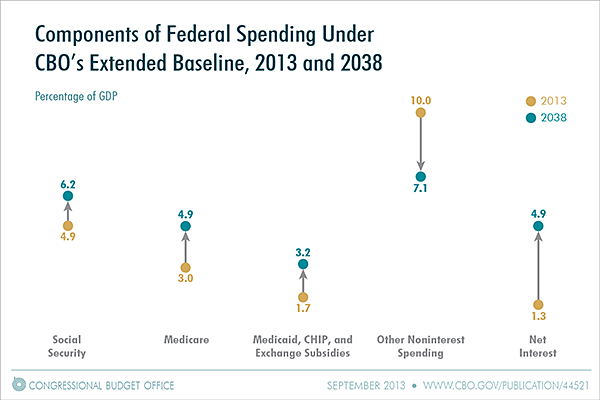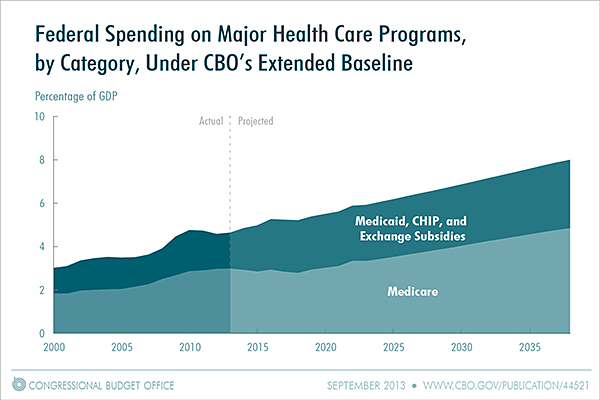Yesterday CBO released The 2013 Long-Term Budget Outlook. In that report, CBO projects that budget deficits, although projected to decline over the next few years, would gradually rise again under current law, mainly because of increasing interest costs and growing spending for Social Security and the government’s major health care programs—Medicare, Medicaid, the Children’s Health Insurance Program (CHIP), and the subsidies that will be provided starting in 2014 through the newly established health insurance exchanges (see the figure below). In this post I will provide more detail about the outlook for health care spending.
Two related posts today—one about Medicare and the other about Medicaid—will provide some key facts and figures about those health insurance programs. Two more posts—to appear tomorrow—will provide an overview of Social Security and of spending on other federal programs. Those four posts are meant to be quick references to learn about key areas of the federal budget. (All of the information appears in yesterday’s report.)

How Has Spending for the Major Health Care Programs Changed Over Time and What Are CBO’s Long-Term Projections of Spending for Those Programs?
Although spending for health care in the United States has grown more slowly in recent years than it had previously, high and rising levels of such spending continue to pose a challenge not only for the federal government’s two major health insurance programs, Medicare and Medicaid, but also for state and local governments, businesses, and households. Measured as a share of economic output, federal spending for Medicare (net of what are termed offsetting receipts, which mostly consist of premiums paid by beneficiaries) and Medicaid rose from 1.8 percent of gross domestic product (GDP) in fiscal year 1985 to 4.6 percent in 2012. Total national spending on health care services and supplies increased from 4.6 percent of GDP in calendar year 1960 to 9.5 percent in 1985 and to 16.4 percent in 2011, the most recent year for which such data are available.
Under CBO’s extended baseline, which generally relies on an assumption that current law remains in place, federal spending on the government’s major health care programs is expected to rise substantially relative to GDP (see the figure below). Specifically, net federal spending for those programs (that is, spending net of offsetting receipts for Medicare) would grow from an estimated 4.6 percent of GDP in fiscal year 2013 to 8.0 percent in 2038; in that year, 4.9 percent of GDP would be devoted to net spending on Medicare and 3.2 percent would be spent on Medicaid, CHIP, and the exchange subsidies. Beyond 2038, CBO projects, federal health care spending would continue to climb relative to GDP but at a slower rate than has been sustained historically.

What Factors Are Affecting Growth in Health Care Spending?
Health care spending per person has grown faster, on average, than the nation’s economic output per person since calendar year 1985, even after the recent slowdown is factored in. On the basis of a calculation that gives greater weight to more recent years, CBO estimates that growth in health care spending per person (after adjusting for demographic changes) has outpaced growth in GDP per capita by an average of 1.5 percent per year since 1985. Key factors contributing to that faster growth have been the emergence and increasing use of new medical technologies, rising personal income, and the expanding scope of health insurance coverage. Factors that have restrained growth during that period, at least temporarily, include the spread of managed care plans in the 1990s and the recent economic recession, as well as legislated changes in Medicare’s payment policies such as those introduced in the Balanced Budget Act of 1997.
The growth of health care spending cannot exceed economic growth indefinitely, because if it did, total spending on health care would eventually account for all of the country’s economic output—an impossible outcome. Instead, over time, people will try to limit their spending for health care in order to maintain their consumption of other goods and services. Private insurers and employers will adjust the insurance coverage they offer, the benefits they provide, and the amounts and nature of their payments to health care providers. In addition, state governments—which pay a large share of Medicaid’s costs and have considerable influence on those costs—will limit the growth of spending for health care in order to manage their budgets. Those reactions to cost pressures will increase the incentives for health care providers to invest in cost-reducing technologies and to increase efficiency. Thus, even in the absence of changes in federal law, growth in per capita spending on Medicaid and on health care financed through the private sector will gradually slow. The rate of growth of Medicare spending per beneficiary is also likely to slow, though to a lesser extent, even without changes in federal law—reflecting changes in medical practices common to all patients, payment rate changes allowed or required under current law, and the increasing pressure of premiums and cost-sharing amounts, such as copayments and deductibles, on enrollees’ finances.
However, quantifying the extent to which the rate of growth of health care spending will decline under current law is difficult. The growth of such spending relative to the growth of the economy has varied greatly from year to year during the past several decades, so projections of the difference in growth rates in the future are very uncertain. As the projection period lengthens, the uncertainties mount because the likelihood of significant changes in medical practices and technology increases.
A particular challenge currently is estimating the extent to which the recent slowdown in growth can be attributed to temporary factors like the recession or instead reflects more enduring developments. Studies have generally concluded that a portion of the observed reduction in growth cannot be linked directly to the weak economy, and CBO’s own analysis has found no link between the recession and slower growth in spending for Medicare. Accordingly, over the past few years, CBO has substantially reduced its projections of spending on Medicare and
Medicaid during the coming decade and slightly lowered its estimate of the underlying rate of growth for health care spending per person for the country as a whole. CBO’s estimate of that underlying rate takes into account spending trends since 1985 but gives greater weight to the recent experience; because of the pressures to constrain spending growth, the underlying rate is projected to decline gradually in the long run.
In contrast, federal spending for health care will be pushed up in the future by a sharp increase in the number of people receiving benefits from government programs. That increase can be attributed to two main factors. The first is the aging of the population—in particular, the aging of the baby-boom generation (people born between 1946 and 1964)—which will increase the number of people receiving benefits from Medicare by more than one-third over the next decade. The second is the expansion of federal support for health insurance under the Affordable Care Act, which will significantly increase the number of people receiving benefits from
Medicaid and make other people eligible for subsidies for health insurance purchased through exchanges.
Julie Topoleski is an analyst in CBO’s Health, Retirement, and Long-Term Analysis Division.

